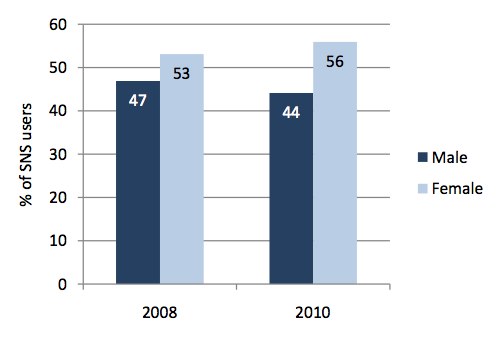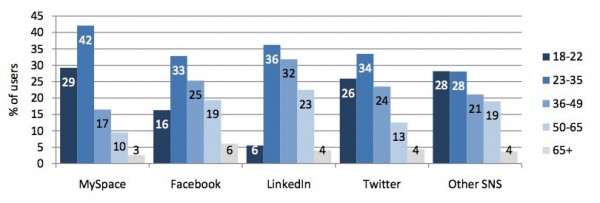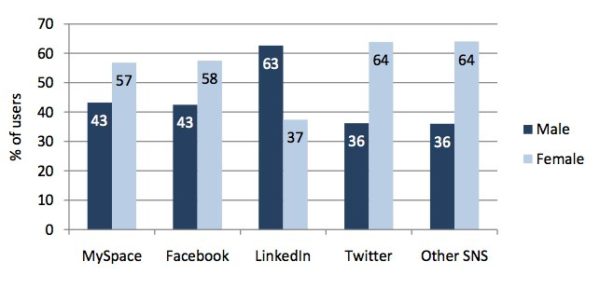A Portrait Of Who Uses Social Networks In The US (And How Social Media Affects Our Lives)
Did you know that out of all social networking users 92% partake in Facebook, 29% participate on MySpace, 18% are on LinkedIn and Twitter is the least utilized network with just 13% usage? Or that males on LinkedIn nearly double the number of females, yet female usage of Twitter almost doubles male usage? Today Pew […]
Did you know that out of all social networking users 92% partake in Facebook, 29% participate on MySpace, 18% are on LinkedIn and Twitter is the least utilized network with just 13% usage? Or that males on LinkedIn nearly double the number of females, yet female usage of Twitter almost doubles male usage?
Today Pew Internet & American Life Project, a project of the Pew Research Center, launched a detailed report on how social networking affects our lives that contains these results and
The goal of this report was to discover what social networking is actually doing to people in their personal offline lives. These are the highlights and conclusions from the 80+ page report.
Who Uses Social Media Networking Sites?
Some of the initial information that Pew Internet presents relates to the social user and who they actually are by age, race and gender.
One of the most weighty stats about social networking usage is the fact that overall social networking usage has nearly doubled from 2008 to 2010. Back in 2008 26% of adults were utilizing a social networking service (SNS) whereas 47% of adults were using a SNS in 2010.
Age
Leading the increase in social networking usage were those over the age of 35, which grew nearly twice as fast as those 18-35 in the same time period. Only 18% of Internet users over the age of 35 used a social networking service in 2008 and by 2010 that number was up to 48%. The average age of an adult SNS user jumped from 33 years old in 2008 to 38 years old in 2010
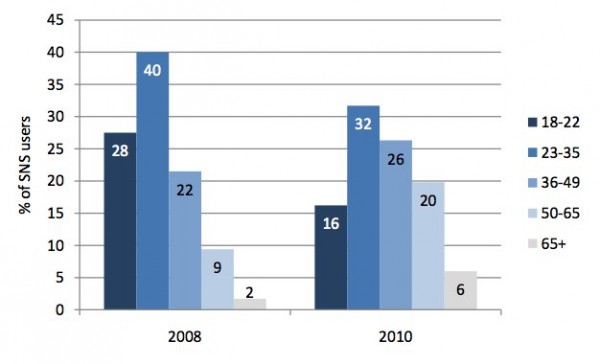
Typical to similar studies the report backs up the fact that social networking users skew female. A notable change showed the discrepancy actually grew from 6% more females in 2008 to 12% more female social networking users in 2010:
 Site-by-Site Breakdown
Site-by-Site Breakdown
One of the most interesting elements of the report is the site-by-site statistics that showed who actually uses the various social networking sites.
Age
A few surprising stats arose from these findings, including the fact that the average MySpace user (32 years old) is younger than both the average Facebook user (38) & Twitter (33) user. LinkedIn skews the highest out of all the networks with users having an average age of 40.
LinkedIn is the only social network that has more men than women and the disparity is rather large with men nearly doubling the number of women. Twitter, on the other hand is almost exactly the opposite of LinkedIn with woman making up 64% of the total users.
The information contained in the report shows that the vast majority of social networking users in the U.S. are white; the lack of minority participation on most networks is staggering.
African-American users have the lowest presence on LinkedIn making up only 2% of the total users. The highest saturation of African Americans is on MySpace with 16% of the total users.
Hispanic users are not prominent on social networking services either. LinkedIn is comprised of only 4% Hispanics, compared to the approximate 14.5% Hispanic makeup of the national population. Hispanics do however make up 12% of both the Twitter and MySpace user base.
LinkedIn is far and away the most saturated site when it comes to white users who make up a whopping 85% of the user base.
Social Networking Usage
Much of the information that Pew Internet uncovered about social usage was expected like MySpace having users who have been members the longest, Twitter having members for the shortest time lengths, but there was some interesting data in regards to everyday usage.
The main finding in regards to usage is that Facebook is far and away the most popular social networking site. Other sites don’t come remotely close to the popularity of Facebook. Of all users on social networks, 92% use Facebook, 29% use MySpace, 18% use LinkedIn and just 13% use Twitter. That’s right, people who have a social networking account are least likely to use Twitter.
Frequency
While Twitter finished in last place out of the main 4 sites the frequency of use of Twitter is quite high. Facebook again leads the pack in frequency of use with 52% of users checking at least once a day, but Twitter is close behind with 33% of users on the service daily:
Facebook Statistics & Usage
Facebook is a focus of this report and thorough usage data and user behavior is included throughout.
Facebook users are quite active in not only using the service, but interacting with others.
- 22% of users comment on another’s post or status
- 26% of users “like” another user’s content
- 15% of users update their own status
- 20% of users comment on another user’s photos
The most active Facebook users tend to be women. 19% of women update their status at least once a day, while men are about half that number (11%) when it comes to daily status updates:
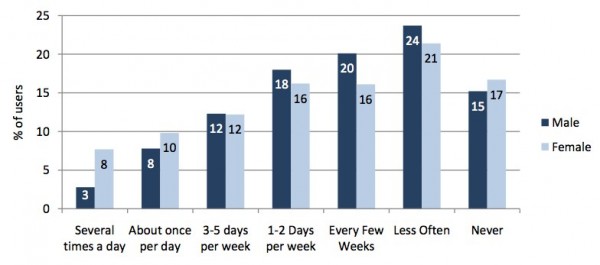
- 44% of users in the 18-22 age range “like” content on a daily basis.
- Men are less likely to “like” Facebook content than women. 20% of women “like” content several times a day compared to just 9% of men.
Breakdown of Friend Relationships
In addition to usage, the report sheds light on the what the most common makeup of Facebook friends might be.
- 22% people from high school
- 12% extended family
- 10% coworkers
- 9% college friends
- 8% immediate family
- 7% people from voluntary groups
- 2% neighbors
Does Social Networking Hinder Real-Life Social Experiences?
The biggest question that Pew Internet wanted to answer with this report was whether or not social networking hindered off line activity and interactions. The answer is clear, it most certainly does not. Not only do SNS fail to retard offline growth, they actually help users develop connections and form stronger relationships in the real world.
Some of the most interesting stats that prove social networks are more than just online relationships are:
- Only 3% of users’ Facebook friends have never met in person. While 89% of all Facebook friends have met in person more than once.
- Internet users have a much more diverse network than those who don’t use the internet. Out of all social networks, LinkedIn users have the most diverse networks.
- The average user of a social networking site has more close ties than a non-Internet user and is half as likely to be socially isolated as the average American.
- Internet Users are more trusting of others than non-Internet users. Facebook users are over 3 times more likely than non-internet users to agree that “most people can be trusted.”
- Social networking users may have more of a life than non-internet users. There is a higher percentage of SNS users to partake in a community group, sports league or youth group than a non-internet user.
Other Interesting Learnings
- Private messages are not frequently used. Only 38% of users claim to use Facebook’s private messages at once a week or more.
- MySpace users have a greater probability to take multiple viewpoints than any other social networking site.
- Internet users are more likely to know their neighbors’ names than non-internet users
- LinkedIn is the only platform that skews male. Nearly twice as many men (63%) as women (37%) use LinkedIn. All other SNS platforms have significantly more female users than male users.
For more information, see Pew Internet for full report stats.
Contributing authors are invited to create content for Search Engine Land and are chosen for their expertise and contribution to the search community. Our contributors work under the oversight of the editorial staff and contributions are checked for quality and relevance to our readers. The opinions they express are their own.
Related stories
